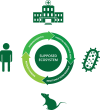Vancomycin gene selection in the microbiome of urban Rattus norvegicus from hospital environment
- PMID: 27412864
- PMCID: PMC4972940
- DOI: 10.1093/emph/eow021
Vancomycin gene selection in the microbiome of urban Rattus norvegicus from hospital environment
Abstract
Background and objectives: Widespread use of antibiotics has resulted in selection pressure on genes that make bacteria non-responsive to antibiotics. These antibiotic-resistant bacteria are currently a major threat to global health. There are various possibilities for the transfer of antibiotic resistance genes. It has been argued that animal vectors such as Rattus norvegicus (R. norvegicus) living in hospital sewage systems are ideal for carrying pathogens responsible for fatal diseases in humans.
Methodology: Using a metagenomic sequencing approach, we investigated faecal samples of R. norvegicus from three major cities for the presence of antibiotic resistance genes.
Results: We show that despite the shared resistome within samples from the same geographic locations, samples from hospital area carry significantly abundant vancomycin resistance genes.
Conclusions and implications: The observed pattern is consistent with a selection for vancomycin genes in the R. norvegicus microbiome, potentially driven by the outflow of antibiotics and antibiotic-resistant bacteria into the wastewater systems. Carriage of vancomycin resistance may suggest that R. norvegicus is acting as a reservoir for possible transmission to the human population.
Keywords: Rattus; antibiotics; metagenomics; rats; selection; vanb; vancomycin; wild.
© The Author(s) 2016. Published by Oxford University Press on behalf of the Foundation for Evolution, Medicine, and Public Health.
Figures


Similar articles
-
Metagenomics of urban sewage identifies an extensively shared antibiotic resistome in China.Microbiome. 2017 Jul 19;5(1):84. doi: 10.1186/s40168-017-0298-y. Microbiome. 2017. PMID: 28724443 Free PMC article.
-
Comparative analysis of the intestinal microbiome in Rattus norvegicus from different geographies.Front Microbiol. 2023 Nov 3;14:1283453. doi: 10.3389/fmicb.2023.1283453. eCollection 2023. Front Microbiol. 2023. PMID: 38029126 Free PMC article.
-
PREVALENCE AND CHARACTERISTICS OF ESCHERICHIA COLI AND SALMONELLA SPP. IN THE FECES OF WILD URBAN NORWAY AND BLACK RATS (RATTUS NORVEGICUS AND RATTUS RATTUS) FROM AN INNER-CITY NEIGHBORHOOD OF VANCOUVER, CANADA.J Wildl Dis. 2015 Jul;51(3):589-600. doi: 10.7589/2014-09-242. Epub 2015 May 1. J Wildl Dis. 2015. PMID: 25932669
-
Metagenomic Insights into Transferable Antibiotic Resistance in Oral Bacteria.J Dent Res. 2016 Aug;95(9):969-76. doi: 10.1177/0022034516648944. Epub 2016 May 16. J Dent Res. 2016. PMID: 27183895 Review.
-
The human gut resistome.Philos Trans R Soc Lond B Biol Sci. 2015 Jun 5;370(1670):20140087. doi: 10.1098/rstb.2014.0087. Philos Trans R Soc Lond B Biol Sci. 2015. PMID: 25918444 Free PMC article. Review.
Cited by
-
Comparative metagenomics analysis reveals how the diet shapes the gut microbiota in several small mammals.Ecol Evol. 2022 Jan 15;12(1):e8470. doi: 10.1002/ece3.8470. eCollection 2022 Jan. Ecol Evol. 2022. PMID: 35136548 Free PMC article.
-
The Threat of Antimicrobial Resistance on the Human Microbiome.Microb Ecol. 2017 Nov;74(4):1001-1008. doi: 10.1007/s00248-017-0985-z. Epub 2017 May 11. Microb Ecol. 2017. PMID: 28492988 Free PMC article. Review.
-
Synanthropic rodents and shrews are reservoirs of zoonotic bacterial pathogens and act as sentinels for antimicrobial resistance spillover in the environment: A study from Puducherry, India.One Health. 2024 May 17;18:100759. doi: 10.1016/j.onehlt.2024.100759. eCollection 2024 Jun. One Health. 2024. PMID: 38784598 Free PMC article.
-
Utilizing the fecal microbiota to understand foal gut transitions from birth to weaning.PLoS One. 2019 Apr 30;14(4):e0216211. doi: 10.1371/journal.pone.0216211. eCollection 2019. PLoS One. 2019. PMID: 31039168 Free PMC article.
-
Urban brown rats (Rattus norvegicus) as possible source of multidrug-resistant Enterobacteriaceae and meticillin-resistant Staphylococcus spp., Vienna, Austria, 2016 and 2017.Euro Surveill. 2019 Aug;24(32):1900149. doi: 10.2807/1560-7917.ES.2019.24.32.1900149. Euro Surveill. 2019. PMID: 31411133 Free PMC article.
References
-
- Wisplinghoff H, Bischoff T, Tallent SM. et al. Nosocomial bloodstream infections in US hospitals: analysis of 24,179 cases from a prospective nationwide surveillance study. Clin Infect Dis 2004;39:309–17. - PubMed
-
- Hidron AI, Edwards JR, Patel J. et al. NHSN annual update: antimicrobial-resistant pathogens associated with healthcare-associated infections: annual summary of data reported to the National Healthcare Safety Network at the Centers for Disease Control and Prevention, 2006-2007. Infect Control Hosp Epidemiol 2008;29:996–1011. - PubMed
-
- Leclercq R, Derlot E, Duval J. et al. Plasmid-mediated resistance to vancomycin and teicoplanin in Enterococcus faecium. N Engl J Med 1988; 319:157–61. - PubMed
LinkOut - more resources
Full Text Sources
Other Literature Sources

